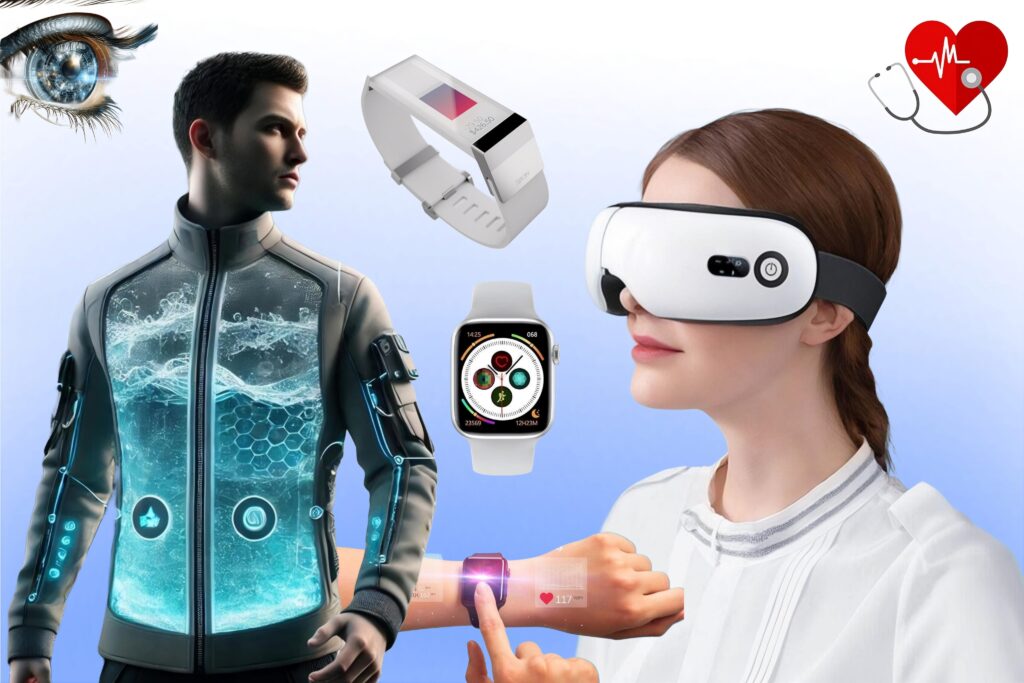Wearable technology has come a long way since the early days of fitness trackers and simple pedometers. While these devices revolutionized how we monitor physical activity and health metrics, the future of wearable tech promises much more. As technology continues to advance at an unprecedented pace, wearable devices are poised to become an integral part of our daily lives, offering benefits that extend far beyond tracking our steps or heart rate. In this article, we will explore the exciting developments in wearable technology and how these innovations are set to transform various aspects of our lives, from healthcare to entertainment, and beyond.

Table Of Contents :
- A New Era in Healthcare
- Continuous Glucose Monitoring
- Wearable ECG Monitors
- Smart Contact Lenses
- Enhancing Daily Life
- Augmented Reality Glasses
- Smart Clothing
- Wearable Payment Devices
- The Intersection of Fashion and Technology
- Designer Wearables
- Customizable Wearables
- Privacy and Security Concerns
- Data Encryption and Privacy Policies
- Ethical Considerations
- The Future of Wearable Tech in Entertainment
- Virtual Reality (VR) Headsets
- Wearable Audio Devices
- The Role of Artificial Intelligence
- Personal Health Assistants
- Predictive Analytics
- Conclusion
A New Era in Healthcare
One of the most promising areas for the future of wearable technology is healthcare. Wearables are already being used to monitor a range of health metrics, such as heart rate, sleep patterns, and blood oxygen levels. However, the next generation of wearable devices will take this a step further by offering more advanced health monitoring and diagnostics.
Continuous Glucose Monitoring
For individuals with diabetes, managing blood sugar levels is a constant challenge. Traditional methods of glucose monitoring involve frequent finger pricks, which can be painful and inconvenient. The future of wearable tech offers a solution in the form of continuous glucose monitors (CGMs). These devices can be worn on the body and provide real-time data on blood glucose levels, allowing users to make informed decisions about their diet, exercise, and medication.
Wearable ECG Monitors
Electrocardiograms (ECGs) are essential for diagnosing and monitoring heart conditions. Wearable ECG monitors, such as those integrated into smartwatches, can provide users with continuous heart monitoring. These devices can detect irregular heart rhythms, such as atrial fibrillation, and alert users to potential issues before they become serious. This proactive approach to heart health has the potential to save lives by enabling early intervention.
Smart Contact Lenses
Another groundbreaking development in wearable tech is the advent of smart contact lenses. These lenses can monitor various health metrics, such as intraocular pressure for glaucoma patients or blood glucose levels for diabetics. Additionally, smart contact lenses can enhance vision by providing augmented reality (AR) overlays, offering users real-time information about their surroundings.
Enhancing Daily Life
Wearable technology is not limited to healthcare; it also has the potential to enhance our daily lives in numerous ways. From improving productivity to providing entertainment, the future of wearables is full of exciting possibilities.
Augmented Reality Glasses
Augmented reality glasses are set to revolutionize the way we interact with the world around us. These glasses can overlay digital information onto the real world, providing users with a seamless blend of physical and virtual realities. For example, AR glasses can display navigation directions, provide real-time translations, or offer information about nearby points of interest. In the workplace, AR glasses can enhance productivity by providing hands-free access to data and instructions.
Smart Clothing
Smart clothing, also known as e-textiles, is another exciting development in wearable tech. These garments are embedded with sensors and electronics that can monitor various metrics, such as body temperature, heart rate, and movement. Athletes can use smart clothing to optimize their training and performance, while individuals with chronic conditions can benefit from continuous health monitoring. Additionally, smart clothing can be used for entertainment purposes, such as creating immersive gaming experiences.
Wearable Payment Devices
As the world becomes increasingly cashless, wearable payment devices are gaining popularity. These devices, often integrated into smartwatches or wristbands, allow users to make contactless payments with a simple tap. This convenience extends beyond payments, as wearable devices can also be used for access control, such as unlocking doors or logging into computers.
The Intersection of Fashion and Technology
The future of wearable tech is not just about functionality; it also involves the intersection of fashion and technology. Designers and tech companies are collaborating to create wearables that are not only useful but also stylish and fashionable.
Designer Wearables
High-end fashion brands are beginning to recognize the potential of wearable technology. Collaborations between tech companies and designers are resulting in wearables that are both functional and aesthetically pleasing. For example, smart jewelry can track fitness metrics while complementing the wearer’s outfit. Similarly, designer smartwatches offer advanced features in a stylish package.
Customizable Wearables
Personalization is a key trend in the future of wearable tech. Users want devices that reflect their individual style and preferences. Customizable wearables allow users to choose from a range of colors, materials, and designs. Additionally, modular wearables enable users to swap out components and features based on their needs and preferences.
Privacy and Security Concerns
As wearable technology becomes more advanced and integrated into our lives, privacy and security concerns are increasingly important. Wearables collect a vast amount of personal data, from health metrics to location information. Ensuring that this data is secure and used responsibly is crucial for the future of wearable tech.
Data Encryption and Privacy Policies
To address privacy concerns, wearable tech companies are implementing robust data encryption and privacy policies. Users should be able to trust that their personal information is protected and only accessible to authorized parties. Transparent privacy policies and user-friendly data management tools can help build this trust.
Ethical Considerations
The ethical implications of wearable technology also need to be considered. For example, employers using wearables to monitor employee productivity must balance the benefits with respect for privacy and autonomy. Similarly, the use of wearables in healthcare should prioritize patient consent and data security.
The Future of Wearable Tech in Entertainment
The entertainment industry is another area where wearable technology is set to make a significant impact. From immersive gaming experiences to personalized music, wearables are poised to revolutionize how we consume entertainment.
Virtual Reality (VR) Headsets
Virtual reality headsets are already popular among gamers, but the future holds even more possibilities. Advances in VR technology will result in more immersive and realistic experiences. Wearable haptic devices, such as gloves and suits, can provide tactile feedback, making virtual interactions feel more real. Beyond gaming, VR has applications in education, training, and therapy, offering users new ways to learn and experience the world.
Wearable Audio Devices
Wearable audio devices, such as smart earbuds and headphones, are evolving to offer more than just music playback. These devices can provide personalized audio experiences, such as adaptive noise cancellation and spatial audio. Additionally, wearable audio devices can integrate with virtual assistants, allowing users to control their smart home devices, send messages, and access information hands-free.
The Role of Artificial Intelligence
Artificial intelligence (AI) plays a crucial role in the future of wearable technology. AI can analyze the vast amounts of data collected by wearables, providing users with valuable insights and personalized recommendations.
Personal Health Assistants
AI-powered personal health assistants can analyze health data collected by wearables and provide users with personalized health advice. For example, an AI assistant can recommend exercise routines, dietary changes, or stress management techniques based on the user’s health metrics. This personalized approach can help users achieve their health and wellness goals more effectively.
Predictive Analytics
Predictive analytics, powered by AI, can enhance the capabilities of wearable tech. By analyzing historical data, AI can predict potential health issues and recommend preventive measures. For example, AI can identify patterns in heart rate variability that may indicate an increased risk of heart disease, allowing users to take proactive steps to improve their heart health.
Conclusion
The future of wearable technology is incredibly promising, with innovations that extend far beyond fitness trackers. From advanced health monitoring and diagnostics to enhancing daily life and entertainment, wearable tech is set to transform various aspects of our lives. As wearables become more integrated into our daily routines, it is essential to address privacy and security concerns to ensure that users can trust these devices with their personal information.
Additionally, the intersection of fashion and technology will play a significant role in the future of wearables, offering users functional devices that are also stylish and customizable. The integration of artificial intelligence will further enhance the capabilities of wearable tech, providing users with personalized insights and recommendations.
As we look to the future, it is clear that wearable technology will continue to evolve and offer new possibilities. Whether it is improving healthcare, enhancing productivity, or providing immersive entertainment experiences, the future of wearable tech holds exciting potential for transforming the way we live, work, and play.


